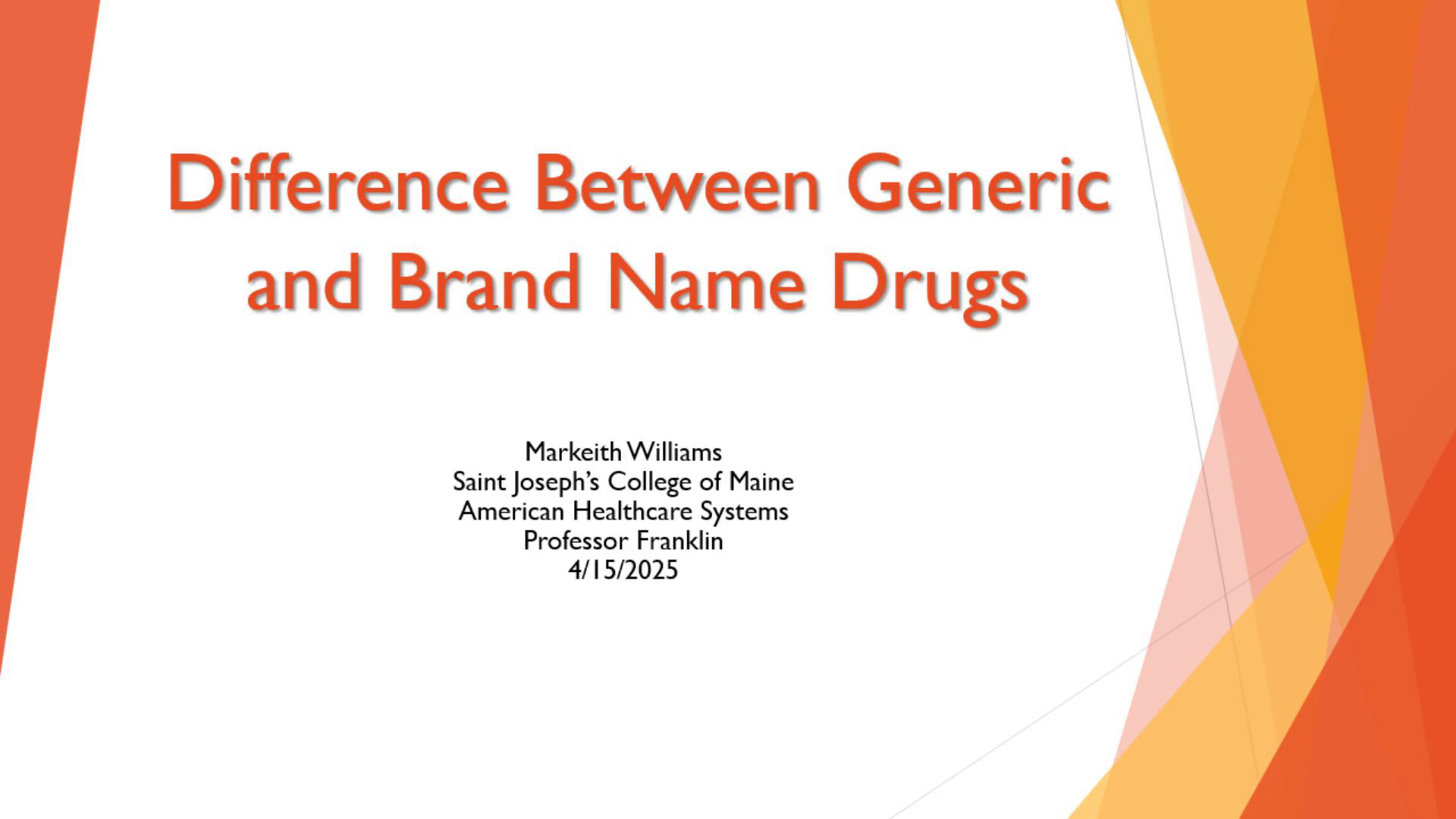Scene 1 (0s)
[Audio] Difference Between Generic and Brand Name Drugs Markeith Williams Saint Joseph’s College of Maine American Healthcare Systems Professor Franklin 4/15/2025.
Scene 2 (12s)
[Audio] Generic Drugs Generic drugs are those manufactured and marketed after the original patent and other exclusive rights have expired (Premanath & Kulkarni, 2024). The manufacturers producing these drugs are not the original innovator companies (patent holding). Generic drugs are underpinned by the bioequivalence concept to foster safety and efficacy in use (Premanath & Kulkarni, 2024). Medicine name, appearance, and packaging may differ from the reference medicine. Generic drugs are cheaper and affordable to most patients (Premanath & Kulkarni, 2024). Quality of generic drugs is depicted as below par compared to the reference drugs. Generic drugs are those medications manufactured and marketed after the original innovator (patent holding) company’s brand name drug’s patent expires (usually after 10 to 20 years) (Premanath & Kulkarni, 2024). These manufacturers can produce the same drug under its generic name without patent protection and other exclusive rights. Generic drugs must contain the same active ingredient, strength, dosage form, and route of administration as the brand name. Although other features may be like the reference medicine, the name of the medicine, its appearance (such as color or shape) and its packaging can be different from those of the reference medicine. Generic drugs are often manufactured without a license from the innovator company, and are marketed only after the expiry date of the patent or other exclusive rights. The main principle underpinning the safe and effective use of generic medicines is the concept of bioequivalence (Premanath & Kulkarni, 2024). Generic drugs are cheaper and affordable to most patients (Premanath & Kulkarni, 2024). The quality of generic drugs is also depicted as below par compared to the reference drugs..
Scene 3 (2m 2s)
[Audio] Brand Name Drugs Brand name drugs are manufactured by pharmaceutical companies holding the original patent. These companies have the right to fix the price of the drug as they deem fit for a specific number of years, normally 10 to 20 years (Premanath & Kulkarni, 2024). The pharmaceutical company chooses the number of the drug name which is easy to remember or market. Brand name drugs undergo rigorous processes before being sold to ensure safety and efficacy for use (Premanath & Kulkarni, 2024). These include: F-D-A approval, rigorous and original clinical trials, and continuous exclusive marketing before generic drugs enter the market Brand name drugs are patented medications as the pharmaceutical companies producing them have the original patent of researching, developing, marketing, and pricing these medications. The companies where the drugs are produced have the right to fix the price of the drug as they feels fit for a specific number of years, which is usually 10 to 20 years (Premanath & Kulkarni, 2024). The brand name is chosen by the company and is typically easy to remember or market. Brand name drugs undergo rigorous processes before being sold to ensure safety and efficacy for use (Premanath & Kulkarni, 2024). These include: F-D-A approval, rigorous and original clinical trials, and continuous exclusive marketing before generic drugs enter the market. Patented medicine.
Scene 4 (3m 33s)
[Audio] Figure 1: Table representation of the differences Features Brand name drugs Generic drugs Patent Protected Original manufactured drugs Not protected Not the original manufactured drug Cost More expensive Significantly affordable (cheaper) Appearance Branded design of the drug May appear different (name, appearance such as color or shape) and packaging) F-D-A requirements F-D-A approval and rigorous clinical trials before use Bioequivalence testing only Quality Higher Considered below the par.
Scene 5 (4m 6s)
[Audio] Impact of Pharmaceuticals on Health Care Costs Positive Impacts Negative Impacts Led to cost saving through the manufacture of generic drugs as more people can afford generic medications. Healthcare systems provide a broader access to innovative medications, especially for underserved populations. Such prevents rehospitalization and wide range of illnesses (Morgan and others, 2020). Production of innovative brand name drugs by pharmaceuticals has increased the cost of health care, especially for patients with chronic disorders like cancer or rare disorders (Morgan and others, 2020). Innovation, inelastic demand for brand name drugs, and competition for necessary medicines lead to increased pricing to cater for research and development, patent protection, and marketing costs (Morgan and others, 2020). A study by Morgan and others (2020) indicates that pharmaceutical innovations over the past years have fostered effective treatment and prevention of different health disorders. The production of generic drugs has led to cost saving as more people can afford generic medications compared to branded medications. Hence, healthcare systems provide a broader access to innovative medications, especially for underserved populations. However, there is a negative impact of pharmaceuticals on health care costs as most patented manufacturers use their market power to maximize profits and this leads to increased treatment prices that are unjustifiable and unaffordable. Production of innovative brand name drugs by pharmaceuticals has increased the cost of health care, especially for patients with chronic disorders like cancer or rare disorders (Morgan and others, 2020). Innovation, inelastic demand for brand name drugs, and competition for necessary medicines lead to increased pricing to cater for research and development, patent protection, and marketing costs (Morgan and others, 2020). Although the demand for medicines is one of the drivers of pharmaceutical expenditure, rising prices are a primary concern for health system managers because medicines are increasingly being priced at levels that appear “unfair.” Such affects the sustainability of the systems that are supposed to drive pharmaceutical innovation..
Scene 6 (6m 23s)
[Audio] References Morgan, S G , Bathula, H S , & Moon, S (2020). Pricing of pharmaceuticals is becoming a major challenge for health systems. BMJ, 368. doi Premanath, M., & Kulkarni, P (2024). Generic Drugs or Branded Generics, Which One You Prefer to Prescribe?. apik Journal of Internal Medicine, 12(3), 195-196. doi.
